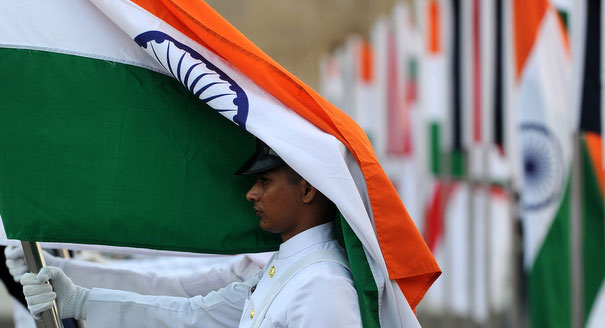Delhi is beginning to sound a lot like Beijing—“India urges both countries to exercise restraint.” With these seven words, released by an Indian Ministry of External Affairs spokesman on May 10, 2012, about recent Sino-Philippine tensions in the South China Sea, India can be seen taking pages from China’s diplomatic playbook. Beijing has long used such turns of phrase to counsel restraint on the part of other powers and to show engagement without direct action. Yet, this does not mean that China is unwilling to dip its toes into external waters. And now neither is India. Delhi is undertaking pronouncements and policies that mirror those of Beijing, particularly when it comes to maritime interests.
India’s Look East policy dates back to the early 1990s, when it was launched in a now-famous directive from the then prime minister, I. K. Gujral, to engage in reciprocity with countries to the east. This led to any number of economic and political ventures that have placed India in closer diplomatic proximity to Southeast Asia. Still, when it comes to the South China Sea, India has remained largely silent. That is, until now.
What may be even more surprising than India’s willingness to weigh in on such disputes, however, is the tone of these statements. They smack of Chinese “diplospeak.” Delhi’s recent statements on the South China Sea reflect those of Beijing, which has often exhorted Delhi and Islamabad to use calm and restraint when facing bilateral tensions. In the late 1990s, this came to be hailed as a more balanced approach toward the two countries. Yet, there is no mistaking that Beijing has a predilection for cooperating with Islamabad at times at a distinct cost to Delhi.
This time around, India has sought to proffer its own counsel to China and its southern neighbors in Mandarin fashion. India’s statements about Sino-Philippine tensions are just the most recent examples. More than rhetoric, India is engaging in political, economic, and military exchanges with countries such as Vietnam, a neighbor with which China has had a historically angst-ridden relationship. This includes the INS Airavat’s July 2011 port call to Vietnam that reportedly led Chinese ships to warn the Indian naval vessel about crossing into the South China Sea. While officially denied, such incidents reflect ambiguities reminiscent of Chinese presence in subcontinental waters.
Much like the Indian reaction to China’s efforts to expand its footprint into South Asia, it should be no surprise that Beijing’s response to such intervention has been less than favorable. Suspicions over intent have been rampant throughout Chinese online articles and journals, particularly in the wake of the Indian Navy’s expanded Milan multinational exercises in February 2012 with fourteen Southeast Asian and South Asian participants, as well as the annual Malabar exercises that add U.S. participation to the mix.
In fact, it could be argued that a reverse, albeit circumscribed, String of Pearls has been emerging in Indian diplomacy. While neither country admits to this Western-conceived strategy, India’s inroads into the South China Sea suggest not simply a mirroring of word and deed throughout the maritime littoral but also an amplification.
Much of this extends from economic interests. But perceptions on both sides have recently undertaken a more security-specific tone. In July 2011, the China Ocean Mineral Resources Research and Development Association received exclusive rights to explore 10,000 square kilometers of seabed in the southwest Indian Ocean. In doing so, China’s Foreign Ministry spokesman invoked the UN Convention on the Law of the Sea to bolster its exploration rights. In best-case Indian assessments, this deal marked further Chinese economic encroachment into the Indian Ocean. In worst-case scenarios, it led some to suggest that China could use this deepwater exploration as a means to facilitate its naval, namely nuclear submarine, ambitions.
Delhi similarly has designs on resource extraction in the South China Sea region, couched in claims of international law. Yet, when confronted with designs of the Indian company Oil and Natural Gas Corporation Ltd. to explore two offshore oil blocks with Vietnam, China’s Foreign Ministry spokesman responded by admonishing India’s involvement in matters beyond its geographic purview. Given that these actions are reminiscent of what Beijing labels as its own “peaceful development, win-win” (heping fazhan, huli shuangying) diplomacy in India’s periphery, however, it becomes harder for Beijing to argue that Delhi should not do the same.
Even if China’s assertions of territorial sovereignty are accepted, India’s intended cooperation with Vietnam on resource extraction barely touches China’s claim. But it has obviously touched a nerve. Given China’s reaction, it is not surprising that Beijing’s distinctive diplomatic phraseology has crept into Delhi’s lexicon when it seeks to explain its interaction with China’s southern neighbors. When describing cooperation with Vietnam and other Southeast Asian partners, Indian commentary has been quick to point out that these ties are not directed at any “third party.” This argument, much as in the case of India’s approach to Sino-Pakistan cooperation, has left few in China convinced.
However, if there is no reason for India to doubt the intent behind Beijing’s dual-use diplomatic rhetoric and actions in China’s Indian Ocean littoral—as frequently claimed by Beijing—then there should be no reason to question the sincerity of Delhi when it comes to the South China Sea. That which is beneficial to one peacefully developing country should make sense for another. Refusal to accept this fact may leave China confronted with yet another term from its lexicon of diplospeak: “double standards” (shuangzhong biaozhun). And until both sides address this mirroring of rhetoric and action, they are bound to continue to knot their String of Pearls and tensions—only this time in reverse.
A shorter version of this article was originally published in the Global Times.









